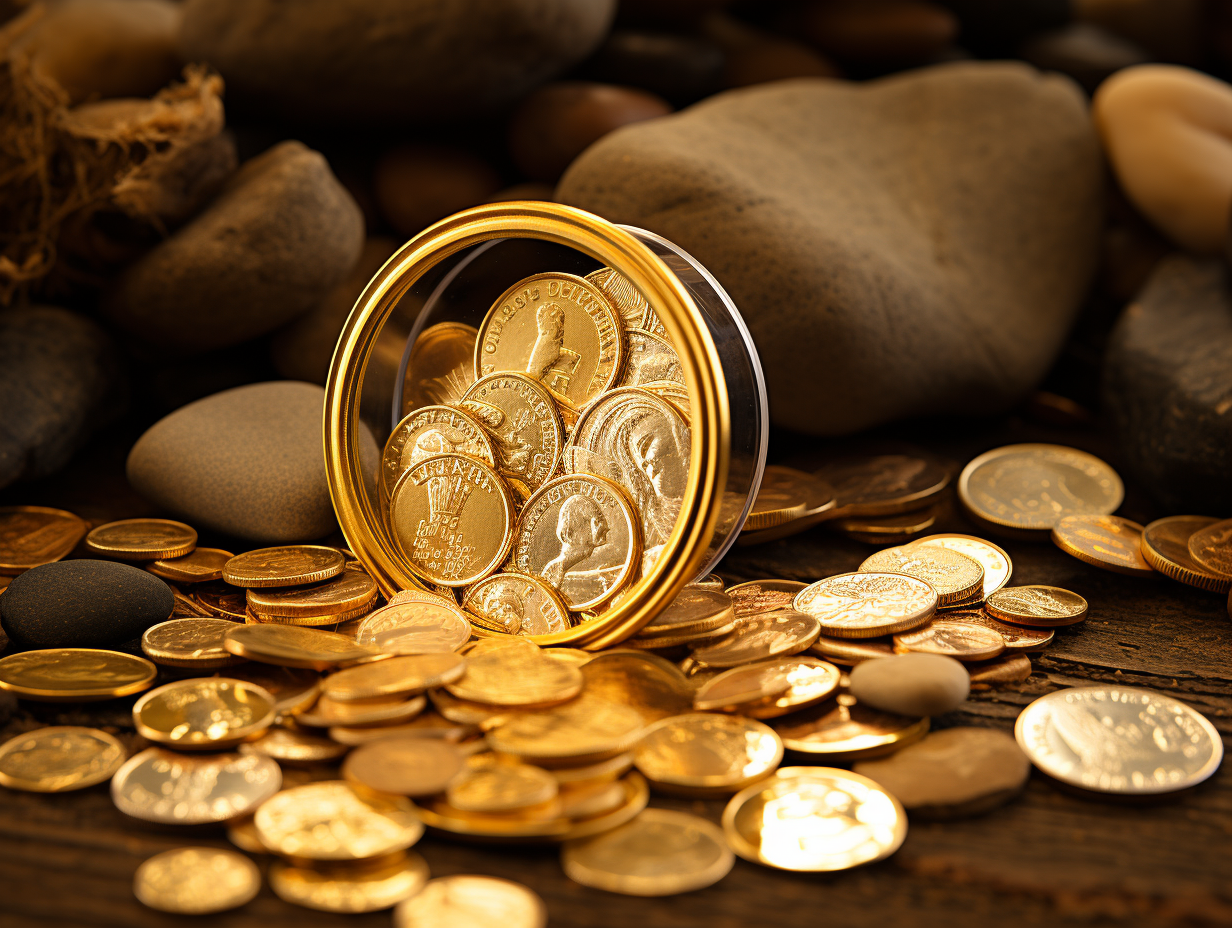In this comprehensive guide, you will uncover everything you need to know about gold coin grading. From understanding the intricacies of coin grading to learning how to differentiate between various grades, this ultimate guide will equip you with the knowledge to accurately assess the quality and value of gold coins. Whether you’re a seasoned collector or just starting out, discover the secrets to becoming an expert in gold coin grading and make informed decisions when it comes to buying or selling these precious treasures.
History of Gold Coin Grading
Ancient Gold Coins
Gold coins have been in circulation for thousands of years, with ancient civilizations such as the Greeks, Romans, and Egyptians minting their own gold coins. These coins were valued not only for their precious metal content but also for their artistic and historical significance. However, the concept of grading gold coins did not exist during these ancient times.
Introduction of Coin Grading
The concept of coin grading began to emerge in the late 19th century, as collectors and investors started to show a keen interest in the quality and condition of coins. This led to the development of standardized grading systems, which aimed to provide a consistent and objective method of evaluating the quality of coins. The first official grading scale was introduced by William H. Sheldon in 1949 and is known as the Sheldon Scale.
Evolution of Grading Standards
Over the years, grading standards for gold coins have evolved and improved. As numismatics became more popular and grading services were established, more factors were taken into consideration when determining the grade of a gold coin. Grading societies such as the Professional Coin Grading Services (PCGS) and the Numismatic Guaranty Corporation (NGC) played a significant role in establishing industry standards and providing trusted grading services.
Factors Affecting Gold Coin Grading
Condition
The condition of a gold coin is one of the most important factors affecting its grade. A coin in pristine condition with no signs of wear or damage will receive a higher grade than a coin with noticeable wear or damage.
Mint State vs. Circulated Coins
Gold coins can be classified as “mint-state” or “circulated” based on their level of wear. Mint-state coins are those that have never been in circulation and exhibit no signs of wear, while circulated coins have been used in commerce and may show varying degrees of wear.
Strike Quality
The strike quality refers to the sharpness and detail of the design on a gold coin. A well-struck coin will have crisp details and clear, defined edges, while a poorly struck coin may have weak or blurred details.
Surface Preservation
The surface preservation of a gold coin refers to its overall condition and the presence of any blemishes, scratches, or discoloration. Coins with well-preserved surfaces will receive higher grades than those with visible imperfections.

Grading Services and their Importance
Professional Coin Grading Services (PCGS)
PCGS is one of the most reputable grading services in the industry. They employ experienced and knowledgeable graders who carefully examine and grade each coin. PCGS provides a guarantee of authenticity and grade, which increases buyer confidence and market liquidity.
Numismatic Guaranty Corporation (NGC)
NGC is another prominent grading service that offers professional and unbiased grading services for gold coins. They maintain strict standards and ensure consistency and accuracy in their grading process. NGC-certified coins are widely accepted and recognized in the numismatic community.
Independent Coin Grading Companies
In addition to the major grading services, there are also independent companies that offer coin grading services. While these companies may not have the same level of recognition and market acceptance as PCGS or NGC, they can still provide a reliable assessment of a coin’s grade.
Understanding Coin Grading Scales
Sheldon Scale (1-70)
The Sheldon Scale, developed by William H. Sheldon, is one of the most widely used grading scales for coins. It ranges from 1 to 70, with 70 being the highest grade. The scale takes into account factors such as wear, strike quality, and surface preservation to determine the overall grade of a gold coin.
Universal Coin Grading Scale (UCGS)
The Universal Coin Grading Scale (UCGS) is another grading scale used by some grading services. It also ranges from 1 to 70, with 70 being the highest grade. The UCGS includes additional factors such as eye appeal and market demand when assigning a grade to a gold coin.

Tools and Equipment for Gold Coin Grading
Magnifying Loupe
A magnifying loupe is an essential tool for examining the fine details of a gold coin. It allows you to closely inspect the coin’s surfaces and identify any imperfections or signs of wear.
Digital Scales
Digital scales are used to accurately measure the weight of a gold coin. The weight of a coin is an important factor in determining its authenticity and grade.
Micrometer
A micrometer is a precision measuring instrument that is used to measure the thickness of a gold coin. Consistency in thickness is a key element in determining the quality and grade of a coin.
Lighting Sources
Proper lighting is crucial when grading gold coins. Different lighting angles and intensities can reveal different details and surface conditions of a coin.
Grading Trays
Grading trays are used to hold and organize coins during the grading process. They provide a stable and clean surface for examining the coins.
Step-by-Step Gold Coin Grading Process
Examine the Coin’s Physical Features
Start by carefully examining the physical features of the gold coin. Look for any signs of wear, scratches, or damage. Pay attention to the overall design, edges, and lettering.
Determine the Coin’s Condition
Evaluate the condition of the gold coin by assessing its level of wear. Mint-state coins should show no signs of wear, while circulated coins may show varying degrees of wear based on their usage and age.
Identify the Coin’s Strike Quality
Examine the sharpness and detail of the coin’s design. A well-struck coin will have clear, crisp details and well-defined edges, while a poorly struck coin may have weak or blurred details.
Assess the Coin’s Surface Preservation
Look for any blemishes, scratches, or discoloration on the coin’s surfaces. Coins with well-preserved surfaces and minimal imperfections will receive higher grades.
Reference Grading Guides and Resources
Consult grading guides, reference books, and online resources to compare the observed characteristics of the coin with established grading standards. This helps in assigning a more precise grade to the gold coin.

Common Grading Errors to Avoid
Overgrading
Overgrading refers to assigning a higher grade to a gold coin than it truly deserves. It can happen due to a lack of experience or bias towards a particular coin. Overgraded coins may have higher price expectations but may not meet the quality standards expected by buyers.
Undergrading
Undergrading occurs when a coin is assigned a lower grade than it deserves. This can happen due to a grader’s inability to identify certain aspects that affect the coin’s grade. Undergraded coins may sell for less than their actual worth.
Improper Handling and Storage
Improper handling and storage of gold coins can lead to damage and decreased value. It is important to use proper handling techniques, such as wearing gloves, and store coins in protective holders or cases to preserve their condition and value.
Tips for Buyers and Sellers
Research and Education
Before buying or selling gold coins, it is important to conduct thorough research and educate yourself about the market, grading standards, and current trends. This knowledge will help you make informed decisions and avoid potential pitfalls.
Seek Professional Opinion
When in doubt about the authenticity or grade of a gold coin, seek the opinion of a reputable professional grading service. Their expertise and unbiased assessment can provide valuable insights and help you make confident buying or selling decisions.
Ask for Certification
When buying or selling high-value gold coins, always ask for a certification from a trusted grading service. A certified coin provides assurance of its authenticity and grade, increasing its marketability and value.
Consider Market Demand and Rarity
Take into account market demand and rarity when buying or selling gold coins. Coins with high demand or limited availability are likely to command higher prices.
Proper Coin Preservation
To maintain the value and preservation of your gold coins, keep them in protective holders or cases and avoid exposure to moisture, extreme temperatures, and pollutants. Regular cleaning and handling with care are essential to preserve their condition.
Value Determination and Market Trends
Factors Influencing Coin Values
Several factors influence the value of gold coins, including their rarity, condition, historical significance, and demand from collectors and investors. Market trends and economic factors also play a role in determining coin values.
Grading and Market Prices
Higher-grade gold coins generally command higher prices in the market due to their superior quality and desirability. Premiums are often associated with coins that have been certified by reputable grading services.
Collecting Trends and Rarity
Collecting trends and the rarity of specific gold coins can significantly impact their value. Coins that are highly sought after by collectors due to their historical significance or limited availability tend to appreciate in value over time.
Spot Gold Prices
Spot gold prices, which reflect the current market price of gold, also influence the value of gold coins. Fluctuations in gold prices can affect the buying and selling prices of gold coins.
Conclusion
Mastering the Gold Coin Grading Process
Understanding the history, factors, and techniques involved in the gold coin grading process is essential for collectors, investors, and enthusiasts. Mastering this process allows for better decision-making, evaluation, and appreciation of gold coins.
Enhancing Investments
By accurately determining the grade and value of gold coins, investors can make informed decisions and potentially enhance their investment portfolios. Precise grading empowers collectors and investors to identify high-quality coins that offer potential growth and value.
Preserving Numismatic Legacy
Proper grading and preservation of gold coins contribute to the preservation of our numismatic legacy. By maintaining the condition and authenticity of these historical artifacts, we ensure their enjoyment and appreciation by future generations.
